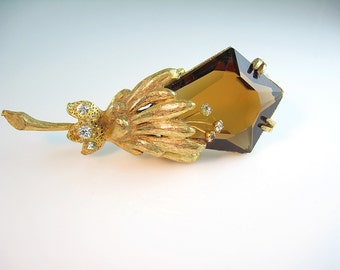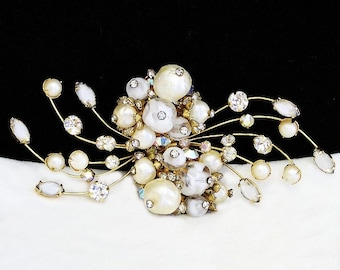Estate
Jewelry usually refers
to jewelry that was previously owned .Jewelry must be at least 100 years old to
be considered antique, and made after the 1940s and through the 1980s to
be considered vintage.
Periods of Estate jewelry
Georgian Jewelry (1714–1837)
Georgian-era
jewelry is handmade and rare. This era often featured nature-inspired designs,
such as leaves, birds, and precious stones. Memento
Mori was a style of jewelry
very popular at the time. The phrase signifies "remember that you will
die" and the style is characterized heavy usage of skull and coffin
motifs.
Photo on courtesy of :https://www.etsy.com/il-en/shop/EstateVintTreasures?ref=l2-shop-header-avatar
Early Victorian, romantic jewelry (1837–1855
Early
Victorian-era jewelry also featured nature-inspired designs, similar to jewelry
of the Georgian era. Frequently, these designs were delicately and intricately
etched into gold. Lockets and brooches were popular in daytime jewelry during
the early Victorian era, whereas colored gemstones and diamonds were worn
during the evening.
Photo on courtesy of:https://www.etsy.com/il-en/shop/Vintageimagine?ref=pr_shop_more
Mid-Victorian, grand jewelry (1856–1880
Because
the Grand or Mid-Victorian era corresponded with the death of Queen Victoria’s
husband, many jewelry pieces have solemn, somber designs. Known as mourning
jewelry, the pieces feature heavy, dark stones. Jet, onyx, amethyst, and garnet
are frequently found in jewelry from this period. Compared to previous periods,
Mid-Victorian-era jewelry feature highly creative, colorful designs using
shells, mosaics and gemstones.
Late Victorian, aesthetic jewelry (1885–1900)
During
the Late Victorian or Aesthetic period, jeweler used diamonds and feminine,
bright gemstones such as sapphire, peridot, and spinel. Star and crescent
designs as well as elaborate hat pins were also popular. Some scholars believe
the aesthetic era began sooner, in 1875, and ended as early as 1890.
Photo on courtesy of:https://www.etsy.com/il-en/shop/JoysShop?ref=pr_shop_more
Arts and Crafts jewelry (1894–1923)
Due to
the Industrial Revolution, many jewelry designers rebelled during the Arts and crafts movement, returning to
intricate jewelry designs and handmade craftsmanship. It was common for jewelry
of this era to be simple in pattern and made of colorful, uncut stones.
Photo on courtesy of:https://www.etsy.com/il-en/shop/SellitAgainVintage?ref=pr_shop_more
Art Nouveau jewelry (1895–1915)
Art
Nouveau jewelry features natural designs such as flowers and butterflies and
were generally considered "romantic." Art Nouveau was a style popular
from about 1895 until World War I. The style actually began around 1875 in
Paris, and its influence went throughout the western world. The style died out
by the end of World War I but has often been revived. Art Nouveau jewelry
follows curves and naturalistic designs, especially depicting long-haired,
sensual women, sometimes turning into bird-like or flower-like forms.
photo on courtesy of:https://www.etsy.com/il-en/shop/boylerpf?ref=pr_shop_more
Edwardian jewelry (1901–1915)
The
Edwardian period began upon the death of Queen Victoria in 1901, when her son
Edward became King. During this period many of the Edwardian-designed pieces
incorporated ₰more expensive gems such as diamonds, emeralds and rubies in
elaborate designs.
Photo on courtesy of:https://www.etsy.com/il-en/shop/PastSplendors?ref=pr_shop_more
Art Deco jewelry
(1915–1935)
Much Art Deco design was a transition from the
earlier Art Nouveau and, as with the Art Nouveau era, was inspired by the art
of the native peoples of the Americas and by ancient Egyptian, Greek and Roman
architecture. Art Deco jewelry motifs are characterized by geometric designs,
diverse combinations of color, and abstract patterns. In 1922, the opening of
Tutankhamen's tomb in Egypt inspired another Egyptian revival. Influences from
cubism as well as African, oriental, Persian, Islamic, and ART
NOUVEAU designs were common
in Art Deco jewelry. The early 1920s' interest in Cubism and Dadaism as a new
art form greatly influenced the Art Deco period. Additionally, the mysteries of
the pyramids and a continuing revival of astrological studies lent themselves
to Art Deco designs, which in turn were incorporated in the Art Moderne period
following 1930.
Art-deco
jewelry is one of the most sought-after jewelry categories, as demonstrated by
auction results.
photo on courtesy of:https://www.etsy.com/shop/OurBoudoir











.jpg)
















